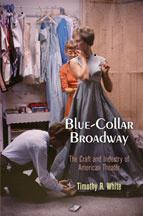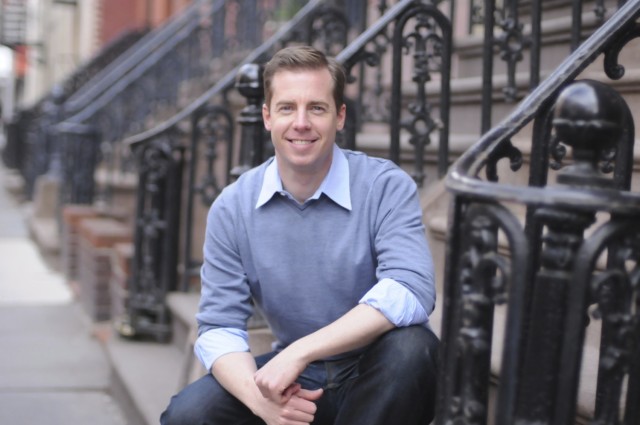NJCU Professor Pens Book on Broadway’s Unsung Artisans
 By Sally Deering
  When some folks see Broadway’s Theater District for the first time they ooh, ah and buy tickets to the show they’re dying to see. When Timothy White, Ph.D., an assistant professor of history at New Jersey City University first saw Broadway, he not only bought tickets, he began researching its glorious history.
 When some folks see Broadway’s Theater District for the first time they ooh, ah and buy tickets to the show they’re dying to see. When Timothy White, Ph.D., an assistant professor of history at New Jersey City University first saw Broadway, he not only bought tickets, he began researching its glorious history.

Dr. White’s curiosity centered on the artists behind the scenes, the nameless crafts men-and-women who sewed the costumes, built the scenery and provided the lights needed to spotlight all those chorus girls in musical showstoppers. White’s curiosity led him to the Library of Performing Arts to write his dissertation for his Columbia University Ph.D. and the result is his first published book BLUE COLLAR BROADWAY: The Craft and Industry of American Theater (pub: University of Pennsylvania Press) now on the shelves of Barnes & Noble and online at Amazon.com.
 In chapters like “Second Hand Roseâ€: The Stage Before the Broadway Brand; and “A Factory for Making Plays†Broadway’s Industrial District, White takes readers on a guided tour of what it was like when the shops and businesses in the theater district were all a part of the Great White Way, where theater artisans built the scenery, costumes, lights, and everything else that went into putting on a Broadway show for over a 100 years. White’s book shines a spotlight on the history of those theater people barely remember in Broadway’s theatrical history books.
Professor White took a few minutes of his busy schedule – he just had a performance/reading at Art House Productions in Jersey City with students of NJCU’s theater department singing shows from Broadway shows – and shared his passion for Broadway and its history.
RVO:Â As a history professor, why did you decide to write a book about Broadway?
TW: I was trained as an historian, but I always loved theater especially when I moved from California to New York. It was 1999 and I dove head first into Broadway. I went to as many shows as I could. First off, I had to make up for long time so I went to see Cats and Phantom of the Opera and caught up on the old stuff like Thoroughly Modern Millie, a lot of great shows. I’ve got the brain of an historian and my heart is in Broadway. When I’m done teaching my classes, I’ll drive off and do Community Theater for fun.
RVO: Why a book about the behind-the-scenes world of Broadway and not the stars?
TW: I became fascinated with the theater district and Times Square and I started doing research, I was studying business listings and Yellow Pages (phone directories) and I found backstage businesses were all over the Theater District. All through the 1940s, 50s and 60s, there were dozens of shops and stores in the Theater District – blue collar stuff. When I came to New York, they were no longer there. There are still people doing great craft work in Midtown, but nowhere near as many.
RVO: Where did you do most of your research?
TW: The Lincoln Center Performing Arts Library has the most important archive; the Billy Rose Theater collection is rich. On Broadway, there’s a tremendous focus on design. The art of costuming depends on the sketch and design and it’s an art form. What I was interested in was who built it? Who stitched it together? For my research, I spoke with the award-winning Broadway costumer designer William Ivey Long. He gave me a great perspective on the industry. I tried to balance my interviews with archival materials.
 RVO: Can you share an anecdote from your book?
TW: One of the stories in the book comes from Hal Prince, the incredible director and producer who has had an incredible Broadway career. It goes back to the original production of West Side Story, and in one of the pieces he wrote, he was explaining that in the original costume design, Irene Sharaff created pants the Sharks and Jets could dance in; the material was distressed, dyed and constructed to look like Levi’s. Prince was looking at his budget, and thought couldn’t he they just buy a pile of Levi’s blue jeans down the street? She said, no, absolutely not. The actors couldn’t do that kind of strenuous dancing in Levi’s blue jeans, it couldn’t be done. They could never kick as high as they needed to. That illustrates the importance of costume construction on Broadway It’s also an example that you have to listen to your craftspeople. It makes the art of Broadway possible.
RVO: How about another anecdote?
TW: Another story connects to anyone who was in New York around the 1970s and knows it was such a different Times Square back then. I was tracking fabric suppliers, doing digital searches, and I got a hit on an address on W.45th Street, a police report on a murder by a man who was on the run. A stage fabrics company had closed and in its wake, the empty space was being used as a hangout for criminals. This criminal they were looking for had dismembered a man and put the body parts in Theater District garbage cans. The closure of all these Broadway craft shops left the Theater District vulnerable to this type of activity. The musicals were still opening, but being built outside of Times Square. The decline in Broadway craft in Times Square left a lot of the buildings unrented and run down.
RVO: Your book is at Barnes & Nobles, Drama Book Shop and a new indie book store Little City Books in Hoboken. What was it like seeing your book on the shelf for the first time?
TW: It was a thrill.
RVO: Is there another book in the works?
TW: Yes. I’m looking at the finances of Broadway; the behind-the-scenes of Broadway investments. I’m going to try to argue that a Broadway flop helps to move the art of Broadway forward. You need flops in order to have a hit.
You can purchase Dr. Timothy White’s book “Blue Collar Broadway†at:
amazon.com; Barnes & Noble; Little City Books in Hoboken; and the Drama Book Store in NYC.
  Excerpt from Blue Collar Broadway:
Excerpt from Blue Collar Broadway:
The Craft and Industry of the American Theater
 By Dr. Timothy R. White
 “…Had anyone developed a special curiosity about the people who hammered, painted, and sewed behind the scenes in the commercial theater, they would have been easy to find. Especially prior to the 1970s, such skilled workers were overwhelmingly clustered in one district: Times Square. Despite their ubiquity for many decades, previous histories of this quintessential urban space give short shrift to the carpenters, seamstresses, and other craft experts who brought stage shows to fruition They often operated major supply shops and theater-related contract businesses but have yet to Factor significantly into any history of Times Square.
From a single vantage point, Broadway between 48th and 49th Streets, one can easily trace the prominence of such shops throughout the twentieth century. In August 1936, for example, the visitor to this stretch of Broadway would have quickly encountered theater-related buildings, businesses, and workers. At midday he or she might have seen actors from the Federal Theatre Project’s We Live and Laugh on their way to rehearsal at Ringle Studios, 1607 Broadway. Directly across the avenue, he or she may have spotted the proprietor Morris Orange or one of his seamstresses on lunch break from their costume rental store at 1600 Broadway. Immediately to the north, the visitor may have seen the cast and craftspeople of the play Stork Mad as they walked to the Ambassador Theatre next door.â€
